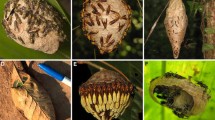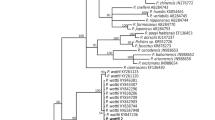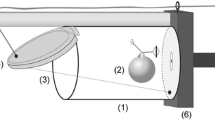Abstract
Various animals build nests with defensive structures to deter predation on offspring. Construction of nest defensive structures can reduce the probability of predation but will involve various costs. Here, we examined both the costs and benefits of the construction of a nest defensive structure in a paper wasp, Polistes chinensis antennalis, and clarify whether the paper wasp changes the level of defensive structures of nests depending on predation risk. A foundress (queen) of the paper wasp starts a colony in spring and maintains her nest alone until the emergence of workers. At this stage, pupae in the nests are sometimes preyed on by conspecifics of other nests. The intruder needs to break the cocoon, which seals the entrance of the cell, to extract the pupa from the cell. Foundresses often apply nest material (pulp) to the surface of cocoons in their nests. We found that pulp on a cocoon increased the time an intruder required to break the cocoon. This result shows that the pulp structure on cocoons helps to prevent predation on pupae. On the other hand, pulp on cocoons involved costs, including time required to collect pulp and being a potential obstacle to the emergence of workers from the cocoon. Additionally, we found that the amount of pulp on cocoons was greater in nests under higher predation risk than nests under lower predation risk. These results suggest that pulp on cocoons is a nest defensive structure, and foundresses adjusted the construction of the defensive structure depending on predation risk.




Similar content being viewed by others
References
Abramoff MD, Magelhaes PJ, Ram SJ (2004) Image processing with ImageJ. Biophotonics Int 11:36–42
Boyero L, Rincón PA, Bosch J (2006) Case selection by a limnephilid caddisfly [Potamophylax latipennis (Curtis)] in response to different predators. Behav Ecol Sociobiol 59:364–372
Brown CG, Funk DJ (2010) Antipredatory properties of an animal architecture: how complex faecal cases thwart arthropod attack. Anim Behav 79:127–136
Caro T (2005) Antipredator defenses in birds and mammals. The University of Chicago Press, Chicago
Collias N (1986) Engineering aspects of nest building by birds. Endeavour 10:9–16
Collias NE, Collias EC (1984) Nest building and bird behaviour. Princeton University Press, Princeton
Creel S, Winnie JA (2005) Responses of elk herd size to fine-scale spatial and temporal variation in the risk of predation by wolves. Anim Behav 69:1181–1189
Edmunds M (1974) Defence in animals: a survey of anti-predator defences. Longman, Harlow
Eisner T, Eisner M (2000) Defensive use of a fecal thatch by a beetle larva (Hemisphaerota cyanea). Proc Natl Acad Sci USA 97:2632–2636
Fowler LE (1979) Hatching success and nest predation in the green sea turtle, Chelonian mydas, at Tortuguero, Costa Rica. Ecology 60:946–955
Furuichi S, Kasuya E (2013a) Hurrying foragers fail to choose the best prey item: prey choice in paper wasps depredating conspecific nests. Ethology 119:786–792
Furuichi S, Kasuya E (2013b) Mothers vigilantly guard nests after partial brood loss: a cue of nest predation risk in a paper wasp. Ecol Entomol 39:339–345
Hagiwara Y, Kojima J (1994) Options in construction behavior for Polistes mandarinus Saussure nesting on Japanese cedar twigs (Hymenoptera: Vespidae). J Kansas Entomol Soc 67:126–128
Hansell MH (1996) The function of lichen flakes and white spider cocoons on the outer surface of birds' nests. J Nat Hist 30:303–311
Hansell MH (2005) Animal architecture. Oxford University Press, Oxford
Jeanne RL (1972) Social biology of the Neotropical wasp Mischocyttarus drewseni. Bull Mus Comp Zool 144:63–150
Jeanne RL (1975) The adaptiveness of social wasp nest architecture. Q Rev Biol 50:267–286
Kasuya E (1980) Behavioral ecology of Japanese paper wasps, Polistes spp. (Hymenoptera: Vespidae) I. Extranidal activities of Polistes chinensis antennalis. Res Popul Ecol 22:242–254
Kasuya E (1983a) Behavioral ecology of Japanese paper wasps, Polistes spp. ІІ. Ethogram and internidal relationship in P. chinensis antennalis in the founding stage (Hymenoptera: Vespidae). Z Tierpsychol 63:303–317
Kasuya E (1983b) Behavioral ecology of Japanese paper wasps, Polistes spp. III. Decision making by P. chinensis antennalis foundresses at the departure from nests. J Ethol 1:15–21
Kasuya E, Hibino Y, Itô Y (1980) On “intercolonial” cannibalism in Japanese paper wasps, Polistes chinensis antennalis Pérez and P. jadwigae Dalla Torre (Hymenoptera: Vespidae). Res Popul Ecol 22:255–262
Kojima J (1982) Nest architecture of three Ropalidia species (Hymenoptera: Vespidae) on Leyte Island, the Philippines. Biotropica 14:272–280
Kudô K (2000) Variable investments in nests and worker production by the foundresses of Polistes chinensis (Hymenoptera: Vespidae). J Ethol 18:37–41
Kudô K (2002) Daily foraging activities and changes of allocation pattern of proteinaceous resources in pre-emergence laboratory foundresses of Polistes chinensis (Hymenoptera; Vespidae). Sociobiology 39:243–257
Kudô K, Yamane S, Yamamoto H (1998) Physiological ecology of nest construction and protein flow in pre-emergence colonies of Polistes chinensis (Hymenoptera Vespidae): effects of rainfall and microclimates. Ethol Ecol Evol 10:171–183
Leader N, Yom-Tov Y (1998) The possible function of stone ramparts at the nest entrance of the blackstart. Anim Behav 56:207–217
Lima SL, Bednekoff PA (1999) Temporal variation in danger drives antipredator behavior: the predation risk allocation hypothesis. Am Nat 153:649–659
Lima SL, Mitchell WA, Roth TC (2003) Predators feeding on behaviourally responsive prey: some implications for classical models of optimal diet choice. Evol Ecol Res 5:1083–1102
Manicom C, Schwarzkopf L, Alford RA, Schoener TW (2008) Self-made shelters protect spiders from predation. Proc Natl Acad Sci USA 105:14903–14907
Martin SJ (1992) Colony defence against ants in Vespa. Insect Soc 39:99–111
Mayer PM, Smith LM, Ford RG, Watterson DC, McCutchen MD, Ryan MR (2009) Nest construction by a ground-nesting bird represents a potential trade-off between egg crypticity and thermoregulation. Oecologia 159:893–901
McKie BG (2004) Disturbance and investment: developmental responses of tropical lotic midges to repeated tube destruction in the juvenile stages. Ecol Entomol 29:457–466
Medlin EC, Risch TS (2006) An experimental test of snake skin use to deter nest predation. Condor 108:963–965
Miyano S (1980) Life tables of colonies and workers in a paper wasp, Polistes chinensis antennalis, in central Japan (Hymenoptera: Vespidae). Res Popul Ecol 22:69–88
Mondy N, Cathalan E, Hemmer C, Voituron Y (2011) The energetic costs of case construction in the caddisfly Limnephilus rhombicus: direct impacts on larvae and delayed impacts on adults. J Insect Physiol 57:197–202
Prokop P, Trnka A (2011) Why do grebes cover their nests? Laboratory and field tests of two alternative hypotheses. J Ethol 29:17–22
Development Core Team R (2012) R: a language and environment for statistical computing. R Foundation for Statistical Computing, Vienna
Ricklefs RE (1969) An analysis of nesting mortality in birds. Smith Contr Zool 9:1–48
Schuetz JG (2004) Common waxbills use carnivore scat to reduce the risk of nest predation. Behav Ecol 16:133–137
Sih A (2005) Predator–prey space use as an emergent outcome of a behavioral response race. In: Barbosa P, Castellanos I (eds) Ecology of predator–prey interactions. Oxford University Press, Oxford, pp 240–255
Smith AP (1978) An investigation of the mechanisms underlying nest construction in the mud wasp Paralastor sp. (Hymenoptera: Eumenidae). Anim Behav 26:232–240
Smith FA (1995) Den characteristics and survivorship of woodrats (Neotoma lepida) in the eastern Mojave Desert. Southwest Nat 41:366–372
Spradbery JP, Kojima J (1989) Nest descriptions and colony populations of eleven species of Ropalidia (Hymenoptera, Vespidae) in New Guinea. Jpn J Entomol 57:632–653
Stanley TR (2002) How many kilojoules does a black-billed magpie nest cost? J Field Ornithol 73:292–297
Strassmann JE, Queller DC, Hughes CR (1988) Predation and the evolution of sociality in the paper wasp Polistes bellicosus. Ecology 69:1497–1505
Suzuki T (1978) Area, efficiency and time of foraging in Polistes chinensis antennalis Pérez (Hymenoptera, Vespidae). Jpn J Ecol 28:179–189
Venner S, Bel-Venner MC, Pasquet A, Leborgne R (2003) Body-mass-dependent cost of web-building behavior in an orb weaving spider, Zygiella x-notata. Naturwissenschaften 90:269–272
Withers PC (1977) Energetic aspects of reproduction by the cliff swallow. Auk 94:718–725
Acknowledgments
We thank all members of our laboratory for their helpful discussions. We appreciate the improvements in English usage made by Edanz Group Japan. The first author is supported by the Global COE Program (Ministry of Education, Culture, Sports, Science and Technology, Tokyo, Japan; Center of excellence for Asian conservation ecology as a basis of human–nature mutualism). The second author is supported by Grant-in-Aid for Challenging Exploratory Research (no. 25650149) and Grant-in-Aids for Scientific Research from the Japan Society for the Promotion of Science (no. 22370010) and the Environment Research and Technology Development Fund (S9) of the Ministry of the Environment, Tokyo, Japan.
Author information
Authors and Affiliations
Corresponding author
Additional information
Communicated by W. T. Wcislo
Electronic supplementary material
Below is the link to the electronic supplementary material.
Predation by a foundress of P. chinensis on a pupa in another conspecific nest. The playback speed is 4× real-time (MPG 5215 kb)
Rights and permissions
About this article
Cite this article
Furuichi, S., Kasuya, E. Costs, benefits, and plasticity of construction of nest defensive structures in paper wasps. Behav Ecol Sociobiol 68, 215–221 (2014). https://doi.org/10.1007/s00265-013-1636-0
Received:
Revised:
Accepted:
Published:
Issue Date:
DOI: https://doi.org/10.1007/s00265-013-1636-0




